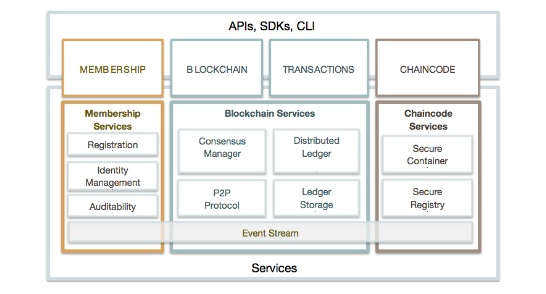The diagram below represents technology architecture viewpoint of hyperledger blockchain framework:

Figure 1. Hyperledger technology architecture viewpoint
Hyperledger framework comprises of four key services/modules at a broader level. They are following:
- Membership services. Membership services comprise of components such as following:
- Registration: Registers/enrolls the new users
- Identity management: Manages identity of the users
- Audit management
- Blockchain services: Blockchain services comprise of following components used to manage consensus, storage and transactions:
- Consensus Manager: Used to implement consensus algorithm; Allows to plug-in extensible/customized consensus module. Consensus manager forms part of ordering service which validates the transaction using VSCC (validation system chaincode), create block of transaction and send them back to peer nodes.
- Distributed Ledger
- Ledger storage: Storage such as LevelDB or CouchDB can be used.
- P2P Protocol: Involves the peer nodes which act as endorsers and committers and how they interact with each other and ordering service (consenter). Endorsers endorses the proposal by executing chaincode using ESCC (endorser system chain code).
- Chaincode services: Chain code services comprise of containers and related services which are used to execute the chain code in a secured environment.
- Client SDKs/APIs: App uses client SDKs/APIs to connect to peer nodes.
Get further details from Hyperledger documentation.
Latest posts by Ajitesh Kumar (see all)
- Coefficient of Variation in Regression Modelling: Example - November 9, 2025
- Chunking Strategies for RAG with Examples - November 2, 2025
- RAG Pipeline: 6 Steps for Creating Naive RAG App - November 1, 2025
I found it very helpful. However the differences are not too understandable for me